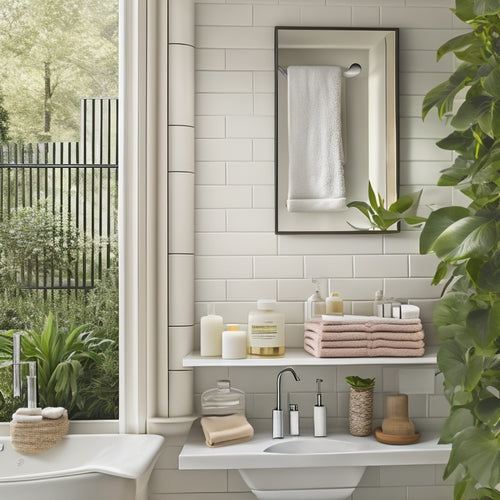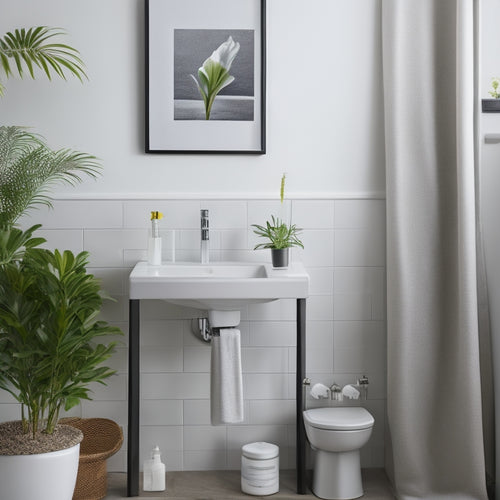
Accessible Storage Solutions for Easy Disability Living
Share
You're taking the first step towards reclaiming your independence by exploring accessible storage solutions. By incorporating simple yet effective design elements, such as grab bars, adjustable shelving, and pull-out drawers, you can break free from cluttered spaces and limited mobility. Streamline your daily routines with easy-to-use storage solutions that cater to your unique needs. With carefully chosen fixtures and thoughtful design, you can regain control over your daily living and rediscover your independence. As you explore these solutions further, you'll discover how to create a living space that empowers you to live life on your own terms.
Key Takeaways
• Incorporate adjustable shelving and storage to accommodate individual needs and preferences.
• Install grab bars in strategic locations for added support and balance.
• Opt for furniture with built-in storage to reduce clutter and enhance accessibility.
• Utilize pull-out drawers and shelves to minimize bending and straining.
• Consider vertical storage options to maximize space and reduce obstacles.
Bathroom Accessibility Essentials
When it comes to creating a comfortable and safe bathroom space, you frequently find that incorporating accessibility essentials is important to ensuring daily routines are manageable and enjoyable.
As you navigate your bathroom, you want to feel secure and confident, especially in areas where water and soap can make surfaces slippery. That's where grab bars installation comes in – strategically placing these bars near the shower, toilet, and bathtub can provide the support and balance you need to move around safely.
Another essential aspect of bathroom accessibility is shower seating options. A shower seat or bench can be a game-changer, allowing you to take a break and rest while showering, reducing fatigue and minimizing the risk of falls.
By incorporating these essentials, you can transform your bathroom into a haven of comfort and independence, empowering you to take control of your daily routine.
Maximizing Space for Wheelchairs
Prioritizing wheelchair accessibility is crucial as you navigate your living space, as you're likely aware of the challenges that come with limited mobility.
This starts with maximizing the space around you to create a more accessible environment.
Clearing Cluttered Paths
You'll need to remove any obstacles that could impede your wheelchair's movement, ensuring you can easily navigate through your home. Clearing cluttered paths is important for effortless Path Navigation. To create a smooth floor plan, identify areas that hinder your wheelchair's movement. Remove any unnecessary items, rearrange furniture, and optimize your space to facilitate easy movement.
Here's a checklist to help you get started:
| Obstacle | Solution |
|---|---|
| Cluttered hallways | Remove unnecessary items, consider storage units |
| Narrow doorways | Widen doorways or install sliding doors |
| Heavy furniture | Rearrange or replace with lighter alternatives |
| Thick carpets | Replace with smooth, wheelchair-friendly flooring |
| Electrical cords | Secure cords with cable organizers or tape |
Optimizing Wheelchair Radius
By rearranging your furniture and removing obstacles, you've created a more navigable space, but now it's time to focus on optimizing your wheelchair's radius to maximize space and maneuverability within your home. This important step guarantees you can move freely and comfortably, without feeling confined or frustrated.
To optimize your wheelchair's radius, start by identifying the minimum clearance required for your chair. Typically, this is around 36 inches, but it may vary depending on your specific wheelchair model. Measure the width of your wheelchair and add a few inches for comfort and ease of movement. This will give you the ideal wheelchair clearance.
Next, assess your home's layout and create turning spaces that accommodate your wheelchair's radius. Consider creating circular paths or removing any narrow corridors that might hinder your movement. By doing so, you'll enjoy greater freedom and independence, effortlessly gliding through your home with confidence and control.
Easy-to-Use Storage Solutions
As you're designing your storage solutions, you'll want to prioritize ease of use, especially if you or a loved one has mobility or dexterity limitations.
That's where simple shelf designs, ergonomic cabinet handles, and adjustable storage heights come in - these features can make a huge difference in your daily life.
Simple Shelf Designs
Simple shelf designs can provide easy-to-use storage solutions for your belongings, freeing up space and reducing clutter in your home. As someone living with a disability, you know how important it's to have a system that works for you, not against you. That's why incorporating simple shelf designs into your storage strategy can make a world of difference.
Floating shelves, for instance, are a great option for those who struggle with heavy lifting or bending. By installing shelves at a comfortable height, you can easily access your belongings without straining yourself.
Corner shelves are another excellent choice, as they maximize the often-wasted space in the corners of your room. This clever design allows you to store items like books, decorations, or linens, keeping them out of the way but still within reach.
Ergonomic Cabinet Handles
You'll appreciate the convenience of ergonomic cabinet handles, which are specifically designed to reduce strain on your hands and wrists, making it easier to open and close cabinets with minimal effort. These handles are crafted with your comfort in mind, allowing you to access your storage spaces without exerting excessive force.
When it comes to handle materials, you'll find a range of options to suit your needs. From durable metals to ergonomic plastics, each material is chosen for its ability to provide a comfortable grip.
Speaking of grip options, you'll be pleased to discover a variety of designs that cater to different hand sizes and abilities. Contoured grips, for instance, fit snugly in the palm of your hand, while textured handles provide extra traction. Some ergonomic handles even feature built-in wrist supports, further reducing strain on your joints.
Adjustable Storage Heights
Having the flexibility to customize your storage space is essential, and adjustable storage heights let you tailor your shelves and compartments to fit your unique needs, ensuring everything is within comfortable reach. This is particularly important for individuals with mobility or dexterity impairments, who may need to access items from a seated position or with minimal stretching.
With adjustable storage heights, you can create a customized system that works for you.
For instance, you can:
-
Lower shelves for easy access to frequently used items, reducing strain on your back and joints.
-
Raise upper shelves to store infrequently used items, keeping them out of the way but still accessible with assistance.
-
Customize rack heights to accommodate items of varying sizes, from large bins to small containers.
Disability-Friendly Fixture Options
When choosing fixtures for accessible storage, consider selecting handles and knobs that are easy to grip and operate with one hand, as this can greatly benefit individuals with mobility or dexterity impairments.
This thoughtful design approach is a cornerstone of Universal Design, which aims to create spaces that are usable by everyone, regardless of ability.
In a Smart Home, adaptive technology can be integrated into fixtures, allowing you to control storage systems remotely or with voice commands.
Invisible fixtures, such as recessed handles or touch-to-open drawers, can also enhance accessibility and create a seamless look.
By incorporating these features, you'll create a storage system that's not only functional but also empowering.
With adaptive technology and thoughtful design, you'll be able to navigate your storage space with confidence and independence.
Organizing for Independent Living
By designing your storage space with accessibility in mind, you're now poised to organize your belongings in a way that fosters independent living. This is where you get to take control of your daily routines and schedules, tailoring them to your unique needs and preferences.
To maximize your independence, consider the following strategies:
-
Streamline your daily essentials: Keep frequently used items in easy-to-reach locations, reducing the need for excessive bending or stretching.
-
Create a personalized routine: Establish a daily schedule that works for you, including set times for meals, medication, and self-care activities.
-
Designate a 'launching pad': Designate a specific area, like a hook or tray near the door, as a central spot to store essential items like keys, wallets, and bags.
Simplifying Morning Routines
Your morning routine sets the tone for the rest of the day, so it's important to simplify it in a way that works best for you. By streamlining your morning, you'll feel more in control and empowered to tackle the day ahead.
One effective way to do this is by using Morning Reminders. These can be as simple as post-it notes on your mirror or a reminder on your phone. Write down the essential tasks you need to complete each morning, such as taking medication or doing stretching exercises. Having these reminders in place helps you stay on track and makes certain you don't forget important steps in your routine.
Another valuable tool is creating a Routine Chart. This visual aid helps you break down your morning into manageable tasks, making it easier to stay organized and focused. By checking off each task as you complete it, you'll feel a sense of accomplishment and motivation to keep moving forward.
Frequently Asked Questions
How Do I Ensure My Storage Solutions Comply With ADA Regulations?
To verify ADA compliance, you'll conduct regular storage audits, incorporating accessibility features like clear floor paths and reachable shelves, and stay updated on regulatory updates to guarantee inclusive spaces that empower everyone.
Can I Install Accessible Storage Solutions in a Rental Property?
Setting up accessible storage solutions in a rental property is akin to maneuvering through a maze - it demands meticulous planning and landlord approval. You'll need to secure permission through the landlord approval process, ensuring any modifications align with their requirements.
Are There Any Storage Solutions Designed for Users With Arthritis?
You'll find storage solutions designed specifically for users with arthritis, featuring ergonomic design and adaptive tools that reduce strain and discomfort, making it easier for you to access and manage your belongings with confidence.
Can I Customize Storage Solutions to Fit My Specific Disability Needs?
"You're not alone: 1 in 5 people live with a disability. Fortunately, you can customize storage solutions to fit your unique needs. With Personalized Shelves and Adaptive Furniture, you can create a tailored space that empowers independence and ease."
Are There Any Smart Home Storage Solutions for People With Disabilities?
You can explore smart home storage solutions tailored to your needs, featuring voice-assisted systems, touchless sensors, automated shelves, and smart cabinets, allowing you to effortlessly manage your space with ease and independence.
Related Posts
-

Creative Open Shelving for Bathroom Displays
You're looking to change your bathroom into a serene oasis, and creative open shelving is the perfect way to showcase...
-

Top-Selling Bathroom Organization Ebook - Only $0.99
This top-selling bathroom organization eBook, available for instant purchase at an unbeatable price of $0.99, provide...
-

Newspaper Headline:Campus Resource Hub Enhances Student Experience
The Campus Resource Hub offers a thorough and inclusive environment that supports the academic, social, and personal ...


